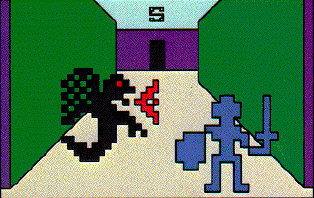Like many kids who grew up in the 1980s, I was first exposed to a computer at school. I had played Pong since I was very young, and our family had an Atari with all sorts of games, but still, there was something quite different about a computer. I must admit I was quite hooked from my first experience. One summer, my parents sent me to a week long "camp" where, to my delight, I took a course on programming computer games. I actually managed to produce a short and fairly pedestrian adaptation of the arcade classic Moon Patrol, over the span of that week. At the end of the class, though, all I had to show for my work was a dot matrix printout of the program on green and white striped paper. All of the excitement and hard work were for naught, and I was a bit glum about the course coming to a close.
My parents must have noticed my depression, because it was only a few months later when they gave me one of the greatest gifts I ever received: a Texas Instruments TI-99/4A computer. At this point in its lifespan, the TI-99/4A was selling at a tremendous discount, being driven off the market by rival Commodore. That didn't matter one bit to me, as I was now the proud owner of a home computer of my very own. You could program the computer in TI-BASIC, which was similar to the BASIC I had used in my summer camp class. I pored over the manual, picked up magazines that had programs I could type in myself, and even hooked up my cassette recorder to save data on. While the TI-99/4A was an amazing computer system, it also played some excellent video games as well, using a cartridge port reminiscent of the old Atari.

One of my most beloved titles for my TI-99/4A was Tunnels of Doom. It should come to no surprise to longtime readers here at Co-Optimus, or anyone who just read how excited I was to go to programming "camp" for a week in the summer, that I was a nerd as a kid. It was practically a requirement of nerdhood in the 1980s that you played Dungeons & Dragons. While other kids played kickball or chased girls at recess, my friends and I rolled dice and tracked hit points underneath the jungle gym. Tunnels of Doom combined my love for swords and sorcery with my obsession with computers. It was a very early, very primitive iteration of the computer role playing game, a genre that has been amazingly popular for almost three decades of video game history.
Stop me if you've heard this one before: as the game begins, you choose to create a fighter, mage, or thief, and up to four characters can travel together at a time. Exploration takes place in a 3D, first person perspective, and the party of adventurers crawls through the dungeon interacting with fountains, doors, and the like. From time to time, monsters appear, and the action switches to a top down viewpoint. Each character takes turns moving and attacking, casting spells, or using items and the monsters do the same. Hit points are lost and gained, magic is used, and the monsters are finally defeated. At this point, the perspective swaps again and the band of explorers can resume their dungeon crawl. For the modern player, there's nothing new here at all.
